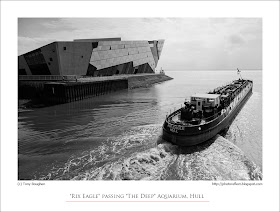I lived in Kingston upon Hull for several years in the 1970s and 1980s. Having been raised in the Yorkshire Dales I found moving from the hills and the drizzle to a port city in drier, brighter Eastern England quite a contrast. Hull has a range of industries along the two rivers on whose banks it stands, and I found a lot of interest and good photographic opportunities in them, as well as in its historic "old town" and docks.
 Residents of this Yorkshire city invariably call it by the name that derives from the narrow river on which it was built - the River Hull. The grander version of the name bequeathed in 1299 by King Edward 1, in preference to Wyke or Wyke upon Hull, is favoured by official bodies but eschewed by the locals. On a brief, recent visit to the city I walked around the area at the confluence of the River Hull and the mighty River Humber into which the lesser river flows. The old pier head remains, but the Humber Bridge did for the "Lincoln Castle" paddle steamer that used to be the means of crossing the Humber from Yorkshire to Lincolnshire. At the junction of the rivers, on a point that once was empty of buildings, a large, futuristic looking new aquarium sits. New crossings span the River Hull, and it was as I stood on the pedestrian bridge over the water that the "Rix Eagle", a fuel bunkering lighter, passed under the tidal barrier, then beneath me, and headed out past "The Deep" into the Humber and downstream towards the commercial docks.
Residents of this Yorkshire city invariably call it by the name that derives from the narrow river on which it was built - the River Hull. The grander version of the name bequeathed in 1299 by King Edward 1, in preference to Wyke or Wyke upon Hull, is favoured by official bodies but eschewed by the locals. On a brief, recent visit to the city I walked around the area at the confluence of the River Hull and the mighty River Humber into which the lesser river flows. The old pier head remains, but the Humber Bridge did for the "Lincoln Castle" paddle steamer that used to be the means of crossing the Humber from Yorkshire to Lincolnshire. At the junction of the rivers, on a point that once was empty of buildings, a large, futuristic looking new aquarium sits. New crossings span the River Hull, and it was as I stood on the pedestrian bridge over the water that the "Rix Eagle", a fuel bunkering lighter, passed under the tidal barrier, then beneath me, and headed out past "The Deep" into the Humber and downstream towards the commercial docks.I photographed the long, barge-like ship as it passed below the tidal barrier, then turning, took another shot as it headed into the Humber. The latter photograph, with a very bright sky, works better in black and white, but the first shot benefits much more from colour.
photograph and text (c) T. Boughen
Main Photo
Camera: Canon
Mode: Aperture Priority
Focal Length: 24mm
F No: f7.1
Shutter Speed: 1/500
ISO: 100
Exposure Compensation: -0.33 EV
Image Stabilisation: On
